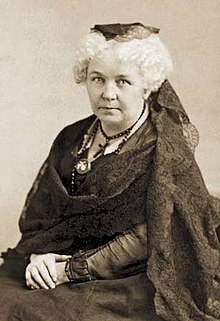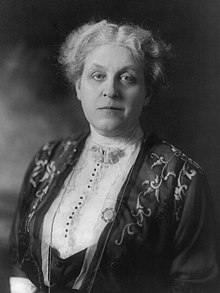User:Yamiurena/sandbox
Seneca Falls Convention's Important Women Figures
[edit]Overview
[edit]Throughout U.S. history, women have taken up vital roles in the efforts to diverge society from the ideal belief that women were inferior factors of the world. Women like Rosa Parks, Harriet Tubman, Susan B. Anthony, and even the late, young Ann Frank were examples of women making a difference in societal norms. The experiences of these and many other famous women in history play a critical role to the interpretations of America’s enriching history. Nevertheless, somehow, we still often manage to overlook the hard work and dedication of a lot of these influential women in our history and lack the inclination to educate effectively on these women’s significant fights for change in old America. A lot of essential aspects of today’s nations have come from the efforts and suffrage of women; such aspects like women’s rights.
From the dedication and work of women, such as Elizabeth Cady Stanton, come the earned and fought-for rights of females to exercise in various circumstances such as sexual freedom, birth control regulation, and voting. One of the most significant times in history that some women played a major role in was that of the Seneca Falls Convention. As already mentioned, one important woman involved was Elizabeth Cady Stanton. However, there are other women that are often neglected and forgotten about from this vital occasion.
In the summer of 1848, from July 19-20, the country's first ever women's right convention was formally held in Seneca Falls, New York[1]. A large number of people (many women, of course) came together and met for two days, setting out to discuss and decide on the social and civil rights of women in the United States[1]. Essentially,this convention was organized to fight for and reform equality for women. With the initiation and cooperation of Elizabeth Cady Stanton and Lucretia Mott, women and men civilians and officials were called and invited to hear out what these women had to say to make a change. On the first day of the conference, only women were encouraged to convene and discuss. On the second day, everyone else attended and were allowed to present and address the public with their thoughts on women's rights. On this second day, Elizabeth Stanton presented her famous speech that she called the Declaration of Sentiments which addressed the discrimination and inequality women in the United States had been facing for years, and called for women to use their strengths to fight for change[2]. By the end of the second day, the Declaration of Sentiments was ratified and signed, along with about twelve other passed resolutions that promoted specific equal rights for women, including the long awaited right to vote[2]. Following the Seneca Falls Convention in New York, national women's rights conferences were annually organized and held in the mission to continue growing the community and prosperity of women's suffrage movements from then on out[1].
Important Figures
[edit]Elizabeth Cady Stanton
[edit]
Elizabeth Stanton was a very important known figure for the 19th century with her dedication to reforming women’s rights. Stanton was born and grew up in New York where she met and married her husband, Henry B. Stanton[3]. Henry B. Stanton was involved with reform and politics and his involvements attracted her to marrying him and attending the World’s Antislavery Convention was their honeymoon[3]. After meeting Lucretia Mott there, Cady Stanton was inspired to look into the history of women’s rights and get involved herself. Stanton had seven children and lived the traditional domestic woman life of that time. This life made her realize the confinement she was in and was not happy. With this as more drive, Stanton got involved with Lucretia Mott in organizing the very first women’s rights convention in the world. After the convention, Stanton continued her hard work in reforming women’s rights on the legislation level and most of the issues she fought for were indeed modified. Stanton was also very passionate in the liberation for women’s emancipation from unhappy marriages. Her fights and advocating made her a prominent figure for women in the 1800’s who were marginalized.
Her involvement with the Seneca Falls convention is especially significant in her left behind legacy. Stanton's address in the Seneca Falls convention shadowed a critical foreseen future for the lives of women during that era. Her speech addressed the prejudice and "bigotry" that was overwhelmingly exercised on these women (by men, especially); it was time for that all to change[2]. With the help of other key players at the convention, Stanton wanted to propose the change in inequality and discrimination against women and one way was through the proposed acquisition of women's right to vote[4]. This proposition was ultimately accepted and ratified, along with other significant "resolutions", paving the way for women in the U.S. and their prospering future and contribution to society[5].
“We hold these truths to be self-evident: that all men and women are created equal” –Elizabeth Cady Stanton[5]
Lucretia Mott
[edit]
Abolitionist and women’s rights activist, Lucretia Mott was among the great leading influences in her time of feminist movements. Mott grew up in a Quaker community from which her perspectives against slave labor and desire to help reform society’s views on slavery developed and led her to the feminist she lived to be[6]. In addition to her anti-slavery motivations, Mott was also avid in equal economic opportunities and voting rights for women--just like Cady Stanton[7]. She was prominent in founding and being an active and important member in different organizations that moved for the abolishing of slavery and, especially, for women’s rights[6]. Such organizations included the Female Anti-Slavery Society, and the American Equal Rights Association[6]. Lucretia Mott was very motivated in trying to educate society and make them believe in the real potential roles of women and eradicate the restrictions and limitations put on women in those times. Her hard work and determination helped give a voice to women of the 19th century; she is one of the many special women whose contribution to the Seneca Falls convention is surely noteworthy and significant to how women's rights are shaped today.
“There is nothing of greater importance to the well-being of society at large—of man as well as woman—than the true proper position of woman.” –Lucretia Mott[8]
Carrie Chapman Catt
[edit]
Women's rights activist as well, Carrie Chapman Catt and her ideas for the Seneca Falls Convention were vital in the actual ratifying and passing of the right for women to vote [9]. Before joining and eventually leading the Woman Suffrage Association, Catt worked as a school teacher and journalist with the inner passion for reforming women's overall rights[9]. Catt was very optimistic in her efforts to win the right for women to vote; so much so that she developed what she called the "winning plans" that would ultimately lead to the hoped victory of that resolution[9]. Her goal centered around the sole focus on women suffrage and the amendments[9]. In the end, victory was won and women, of course, obtained the right to vote; Chapman Catt played a major part in that success and many more after that.
Jane Hunt
[edit]
Jane Hunt is much less talked about key figure from the Seneca Falls Convention. Though her role in the conference was not as exceptionally outstanding, it was still very much relevant and commendable. Hunt was a 19th century American Quaker. She played an important role in the Seneca Falls Convention as she was the one who called for the pre-meeting for the Convention[10]. Inviting other crucial figures including Lucretia Mott, Elizabeth Canton, and Martha Wright, Hunt hosted these women for a pre-convention meeting to organize the memorable Seneca Falls Convention of 1848; an event that would change the world of women for the better[10]. She was another prominent representation of the importance and meaning of the Seneca Falls Convention.
Conclusion
[edit]In conclusion, much of history is often forgotten or neglected. A lot of the important women that were involved in the Seneca Falls Convention are no exception. More often than not, Elizabeth Stanton is the one significant figure that is remembered and highlighted the most for the outcomes of the convention. However, many other special women were important to the cause and the successful results. As American History writer, Sarah M. Evans, expresses herself American women such as Elizabeth Cady Stanton, Lucretia Mott, Carrie Chapman Catt, and Jane Hunt have "reshaped the boundaries of that arena [of politics and citizenship] in [many different] ways[11].
- ^ a b c "Seneca Falls Convention begins - Jul 19, 1848 - HISTORY.com". HISTORY.com. Retrieved 2017-11-20.
- ^ a b c "Declaration of Sentiments and Resolutions, Seneca Falls: Stanton and Anthony Papers Online". ecssba.rutgers.edu. Retrieved 2017-11-30.
- ^ a b "Stanton Biography: Stanton and Anthony Papers Online". ecssba.rutgers.edu. Retrieved 2017-12-07.
- ^ "Elizabeth Cady Stanton". Biography.com. Retrieved 2017-12-07.
- ^ a b "Elizabeth Cady Stanton's Declaration of Sentiments, 1848". www.historyisaweapon.com. Retrieved 2017-12-07.
- ^ a b c "Lucretia Mott - Women's History - HISTORY.com". HISTORY.com. Retrieved 2017-12-07.
- ^ "The Women's Rights Movement and the Women of Seneca Falls". Biography.com. Retrieved 2017-12-07.
- ^ "People Who Spoke Up for Peace". www.thepeacecenter.org. Retrieved 2017-12-07.
- ^ a b c d "Carrie Chapman Catt". Biography.com. Retrieved 2017-12-07.
- ^ a b "Jane Hunt - Women's Rights National Historical Park (U.S. National Park Service)". www.nps.gov. Retrieved 2017-12-07.
- ^ Evans, Sarah M. (1997). Born for Liberty: A History of Women in America. New York: Simon & Schuster. p. 3.
